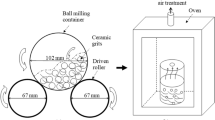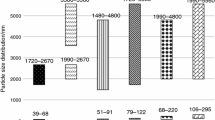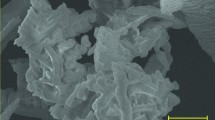Abstract
Three different silica filler materials were thermally treated in order to effect dehydration, dehydroxylation, and rehydroxylation. Samples were characterized by thermogravimetry (TG), pycnometry, elemental analysis, and scanning electron microscopy (SEM). For all fillers, our results indicate incremental removal of silanol groups at higher heating temperatures and irreversible dehydroxylation at over 673 K. To remove the organic content and maintain adequate silanol density for subsequent silanization on Stöber-type silica, we suggest heating at 673 K followed by overnight boiling in water.






Similar content being viewed by others
Notes
Our personal communication with the material suppliers indicated that alfa aesar-05 was synthesized by Stöber process and nalco-2329 was prepared through the sodium silicate route.
References
Graham T. On liquid diffusion applied to analysis. J Chem Soc. 1862;15:216–70.
Graham T. On the properties of silicic acid and other analogous colloidal substances. J Chem Soc. 1864;17:318–27.
Iler RK. The chemistry of silica: solubility, polymerization, colloid and surface properties and biochemistry of silica. New York: Wiley-Interscience; 1979.
Bergna HE, Roberts WO, editors. Colloidal silica: fundamentals and applications. Boca Raton: CRC/Taylor & Francis; 2006.
Klapdohr S, Moszner N. New inorganic components for dental filling composites. Monatshefte für Chemie. 2005;136:21–45.
Hair ML. Hydroxyl-groups on silica surface. J Non-Cryst Solids. 1975;19:299–309.
Maciel GE, Sindorf DW. Si-29 nuclear magnetic-resonance study of the surface of silica-gel by cross polarization and magic-angle spinning. J Am Chem Soc. 1980;102:7606–7.
Sindorf DW, Maciel GE. Si-29 NMR-study of dehydrated rehydrated silica-gel using cross polarization and magic-angle spinning. J Am Chem Soc. 1983;105:1487–93.
Plueddemann EP. Silane coupling agents. New York: Plenum; 1982.
Antonucci JM, Dickens SH, Fowler BO, Xu HHK, McDonough WG. Chemistry of silanes: interfaces in dental polymers and composites. J Res Natl Inst Stand Technol. 2005;110:541–58.
Zhuravlev LT. Concentration of hydroxyl groups on the surface of amorphous silicas. Langmuir. 1987;3:316–8.
Zhuravlev LT. Structurally bound water and surface characterization of amorphous silica. Pure Appl Chem. 1989;61:1969–76.
Zhuravlev LT. The surface chemistry of amorphous silica. Zhuravlev model. Colloids Surf, A. 2000;173:1–38.
Wan Q, Sheffield J, McCool J, Baran G. Light curable dental composites designed with colloidal crystal reinforcement. Dent Mater. 2008;24:1694–701.
Chen GD, Zhou SX, Gu GX, Yang HH, Wu LM. Effects of surface properties of colloidal silica particles on redispersibility and properties of acrylic-based polyurethane/silica composites. J Colloid Interface Sci. 2005;281:339–50.
Stöber W, Fink A, Bohn E. Controlled growth of monodisperse silica spheres in the micron size range. J Colloid Interface Sci. 1968;26:62–9.
Huang WL, Liang KM, Gu SR. Calcining silica gels at different drying stages. Mater Lett. 2000;46:136–41.
Shirai K, Yoshida Y, Nakayama Y, Fujitani M, Shintani H, Wakasa K, et al. Assessment of decontamination methods as pretreatment of silanization of composite glass fillers. J Biomed Mater Res. 2000;53:204–10.
Rasband W. Imagej. U.S. National Institutes of Health, Bethesda, Maryland, USA. 1997–2006. http://rsbinfonihgov/ij.
Abramoff M, Magelhaes P, Ram S. Image processing with imagej. Biophotonics Int. 2004;11:36–42.
Kobayashi M, Skarba M, Galletto P, Cakara D, Borkovec M. Effects of heat treatment on the aggregation and charging of Stöber-type silica. J Colloid Interface Sci. 2005;292:139–47.
Lafargue PE, Gaumet JJ, Muller JF. Analysis of thermally treated silica gel using fourier transform ion cyclotron resonance mass spectrometry. Chem Phys Lett. 1998;288:494–8.
Dugas V, Chevalier Y. Surface hydroxylation and silane grafting on fumed and thermal silica. J Colloid Interface Sci. 2003;264:354–61.
Jethmalani JM, Sunkara HB, Ford WT, Willoughby SL, Ackerson BJ. Optical diffraction from silica-poly(methyl methacrylate) composite films. Langmuir. 1997;13:2633–9.
Labrosse A, Burneau A. Characterization of porosity of ammonia catalysed alkoxysilane silica. J Non-Cryst Solids. 1997;221:107–24.
Wells JD, Koopal LK, de Keizer A. Monodisperse, nonporous, spherical silica particles. Colloids Surf, A. 2000;166:171–6.
Leite CAP, de Souza EF, Galembeck F. Core-and-shell nature of strober silica particles. J Braz Chem Soc. 2001;12:519–25.
Xia Y, Gates B, Yin Y, Lu Y. Monodispersed colloidal spheres: old materials with new applications. Adv Mater. 2000;12:693–713.
Acknowledgements
Support from NIH R21DE018330 is appreciated. We thank Esstech and Nalco for providing materials.
Author information
Authors and Affiliations
Corresponding author
Rights and permissions
About this article
Cite this article
Wan, Q., Ramsey, C. & Baran, G. Thermal pretreatment of silica composite filler materials. J Therm Anal Calorim 99, 237–243 (2010). https://doi.org/10.1007/s10973-009-0139-8
Received:
Accepted:
Published:
Issue Date:
DOI: https://doi.org/10.1007/s10973-009-0139-8




